Business planning is like preparing to build a backyard fort.
First, you dream up your grand idea, just like picturing the perfect fort. Then, you sketch out your action plans, like drawing your fort's design. You also list everything you need, from materials to helpers, akin to gathering wood and nails for your fort. Anticipating challenges, you think ahead about potential problems, like weather or competitors. Finally, you start building step by step, sharing your finished product with friends or customers, making your dream a reality.
Your new fort looks strong. But in some spots, it's weak. You consider the opportunity to make it bigger. Yet, you are also worried about imminent threats.
You know what your fort needs: a SWOT analysis!
The four components of a SWOT Analysis
Thus, the four parts of any SWOT analysis are:
- Strengths
- Weaknesses
- Opportunities
- Threats
Business managers assess these factors during the business strategic planning process to ensure the organization's growth based on these valuable insights. Now, let's study all four parts of SWOT analysis in detail.
First Part of a SWOT Analysis: Strengths

Strengths in a SWOT analysis refer to the internal attributes that provide an organization, individual, or project a competitive advantage in the market.
A competitive advantage is important since it provides an edge to an organization, individual, or project over its market competitors.
Every organization possesses different strengths. Businesses need to identify their strengths since it helps them decide. Organizations that stick to their strengths succeed. Hence, organizations must know their strengths.
The strengths of an organization could be tangible or intangible.
For example, the tangible strengths of an organization would be the technological infrastructure, financial and human resources, while intangible strengths would be the brand recognition and the culture of the organization.
Examples of Strengths
The SWOT analysis of Ralph Lauren identified some of the strengths:
- Global Presence: Ralph Lauren's global presence was identified as its strength since the brand operates in different parts of the world, including the US, Europe, Asia, and the Middle East. Operating in different parts of the world increased the brand's customer base and Ralph Lauren's revenue. Hence, the SWOT analysis highlighted the brand's global presence as its strength.
In our SWOT analysis of Adidas, we focused on this strength:
- Distribution Network: This extensive network allows Adidas to effectively manage the supply chain from production to retail, ensuring timely delivery of products across diverse markets. The brand’s strategic partnerships with reliable logistics providers and its investment in advanced supply chain technologies enhance inventory management, reduce lead times, and optimize cost efficiency.
Second Part of a SWOT Analysis: Weaknesses
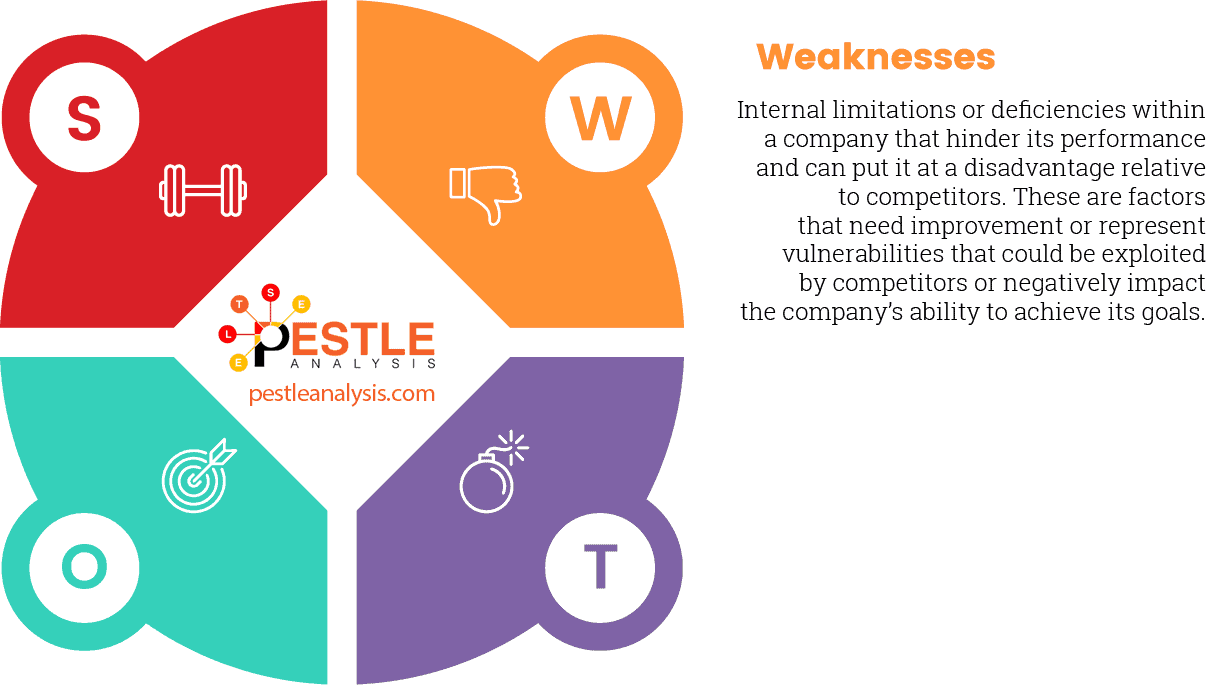
Every organization, individual, or project possesses some weaknesses along with strengths. The weaknesses of an organization are the internal factors that hinder the growth of the organization.
Businesses need to identify the weaknesses so that they can be overcome. SWOT analysis highlights the weaknesses of an organization by analyzing the internal factors that stop it from reaching its true potential.
The SWOT framework then marks areas within the organization that require improvement. The weaknesses identified in the SWOT analysis may be tangible, such as a lack of funds or machinery. On the contrary, they could also be intangible, for example, a lack of skilled labor.
Examples of Weaknesses
The SWOT analysis of Honda highlights some of its weaknesses.
- Over-reliance on the North American Region: The SWOT analysis of Honda proved that a high percentage of Honda's revenue is generated from the North American region. This is considered a weakness of Honda since over-reliance on one region could make the brand suffer in case of political or economic crises in the North American region.
In our SWOT analysis of Amazon, we studied the following factor as a weakness:
- Dependence on Third-Party Sellers: Amazon’s reliance on third-party sellers presents notable challenges. Quality control becomes complicated, leading to issues with counterfeit goods, inconsistent product quality, and fraudulent seller activities, which can harm Amazon’s reputation and customer trust. Additionally, while fees from third-party sellers significantly contribute to revenue, the competitive marketplace forces Amazon to carefully balance incentivizing these sellers while maintaining its own profit margins, creating a delicate equilibrium.
Third Part of a SWOT Analysis: Opportunities
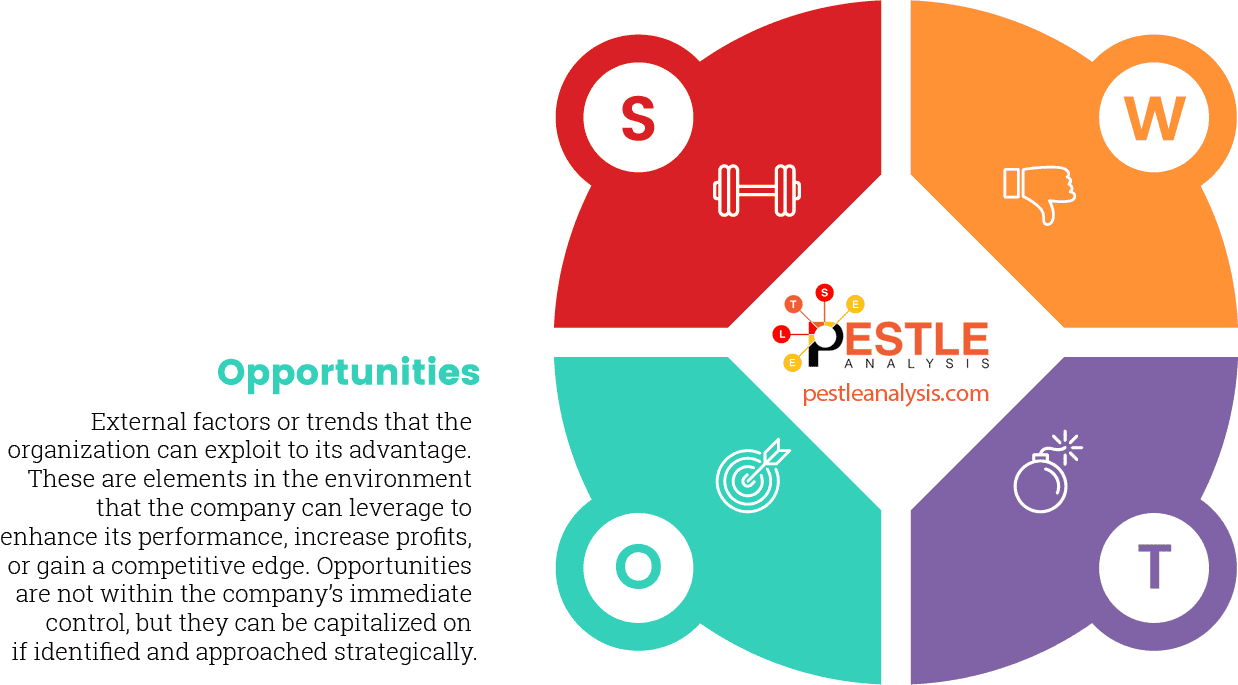
Opportunities are the chances that lie in front of an organization to grow. Every organization gets a chance to grow. However, it is essential to identify the opportunities beforehand to grab them.
SWOT analysis helps organizations to identify the opportunities that lie ahead of them. By doing so, it enables organizations to capitalize on the identified opportunities.
Once the opportunities are identified through SWOT analysis, it becomes easy for organizations to formulate a strategy to capitalize on those opportunities.
Opportunities are external factors since they are not created within the organization.
The purpose of listing the opportunities with the help of SWOT analysis is to steer the organization toward success and growth. Moreover, organizations or even colleges use opportunities to gain a competitive advantage in the market.
Opportunities can be found in various ways. Organizations can conduct market research and analyze market trends and consumer tastes. By doing so, they can adapt and meet the changing market demand, which will increase the organization's customer base.
Besides that, the organization can collect feedback from their customers through surveys. These surveys will help the organization to identify its shortcomings and understand consumer preferences.
Furthermore, organizations can conduct competitor analysis to find areas their competitors lack. Organizations can capitalize on their competitor's weaknesses by positioning themselves to exploit the opportunities effectively.
Examples of Opportunities
In our SWOT Analysis of Starbucks, we pointed out this opportunity:
- Health and Wellness Trends: With the growing interest in health and wellness, Starbucks can introduce more options that cater to health-conscious customers. Think plant-based beverages, low-calorie snacks, and functional drinks infused with vitamins or probiotics. This could attract a whole new segment of customers.
In our Tesco's SWOT Analysis, we studied the following factor as an opportunity:
- Expansion in Emerging Markets: While Tesco has faced challenges internationally, there’s still a lot of potential for growth in emerging markets where the retail sectors are on the rise. Countries with increasing middle-class populations present new customer bases and big growth opportunities. Expanding into these markets could open the door to substantial growth and help Tesco tap into new revenue streams.
In the SWOT analysis of McDonald's, we discussed a few opportunities, such as the following:
- Menu Expansion: One of McDonald’s current weaknesses can be addressed by seizing this opportunity to expand their menu. As a food-centric brand, they have endless possibilities to diversify their offerings globally. The biggest trend they can capitalize on is the demand for healthy eating alternatives. Introducing options for health-conscious customers, whether for weight loss or a healthier lifestyle, would be a smart move. Additionally, they could offer organic and fresh varieties for those who prefer organic food. For now, they’ve started with the introduction of a bigger Big Mac in early 2024, called the Double Big Mac, featuring four all-beef patties.
Fourth Part of a SWOT Analysis: Threats
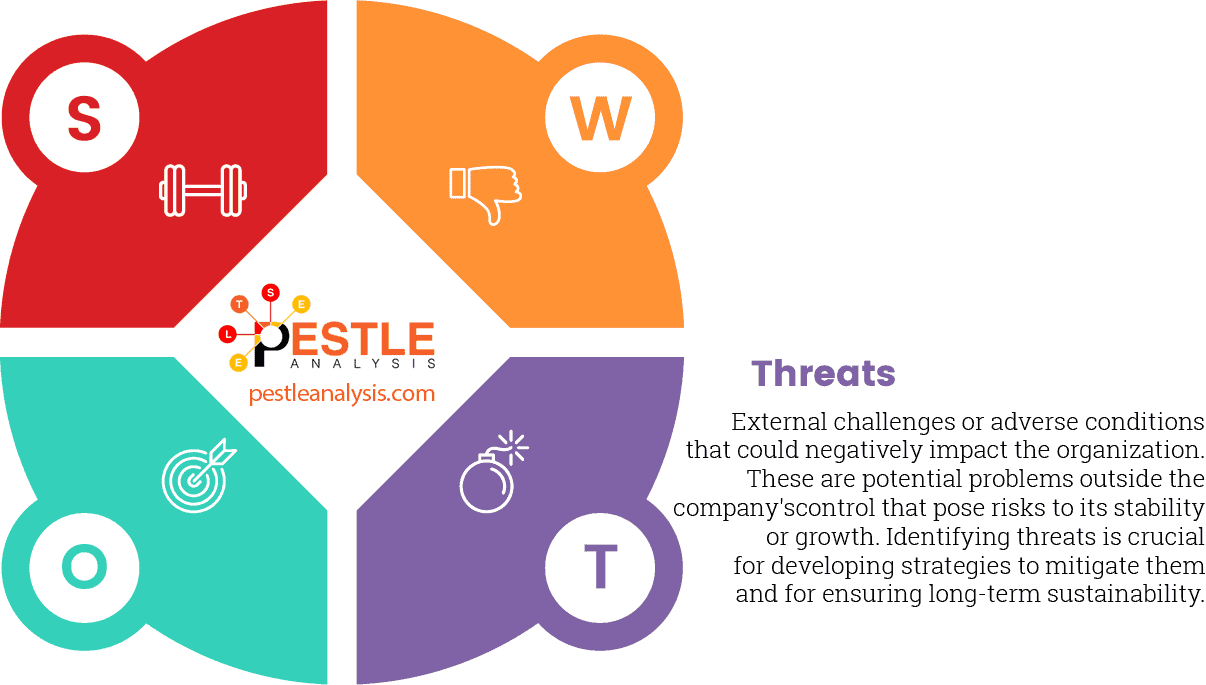
Threats in a SWOT analysis refer to the external factors that risk the success of an organization or a project. Organizations must identify the external threats present to form a strategy to mitigate those threats timely.
One of the threats that organizations face is a threat from the intense competition in the industry. Competition threatens organizations because it divides the market share and causes profits to fall.
Besides that, many companies feel threatened by economic downturns because they cause disposable income to fall, which, as a result, causes the demand in the market to fall.
Furthermore, political instability is also considered a threat since it creates uncertainty, which causes the demand for products to fall.
Identification of threats is possible by conducting a comprehensive risk assessment of the external environment. Moreover, organizations can identify threats by monitoring the external environment, such as market trends, political landscape, and economic landscape.
An organization can also conduct market research to monitor the changing trends. Once the threats are identified, organizations can form effective strategies to counter these threats.
For example, suppose an organization anticipates the threat of change in consumers' tastes.
In that case, it can diversify its products and invest in products that align with consumers' tastes. Moreover, suppose a brand can feel the threat of a war between two countries. In that case, it can wrap up its operations from those countries and move it to another country.
Every organization faces threats from the external environment. However, the damage can be avoided if timely measures are taken.
Examples of Threats
In Uber's SWOT analysis, we found this threat:
- Legal Regulations: New legal challenges present significant threats to Uber’s operations, particularly as seen in Germany and other countries. These regulations can impose restrictions or even outright bans on Uber’s services, leading to a loss of markets and impacting overall revenue.
In our SWOT analysis of Nike, we discussed the following threat:
- Competition: Competitors such as Adidas, Under Armour, Puma, and new market entrants continually vie for market share, often through innovation, aggressive marketing, and competitive pricing. These brands invest heavily in product development and endorsements to attract and retain customers, which can erode Nike’s market dominance. Additionally, niche brands and emerging direct-to-consumer businesses capitalize on specific consumer trends, such as sustainability and customization, challenging Nike’s ability to maintain its broad appeal. This heightened competition necessitates continuous investment in research and development, marketing, and strategic partnerships, which can strain resources and impact profit margins.
The Purpose of Using a SWOT Analysis
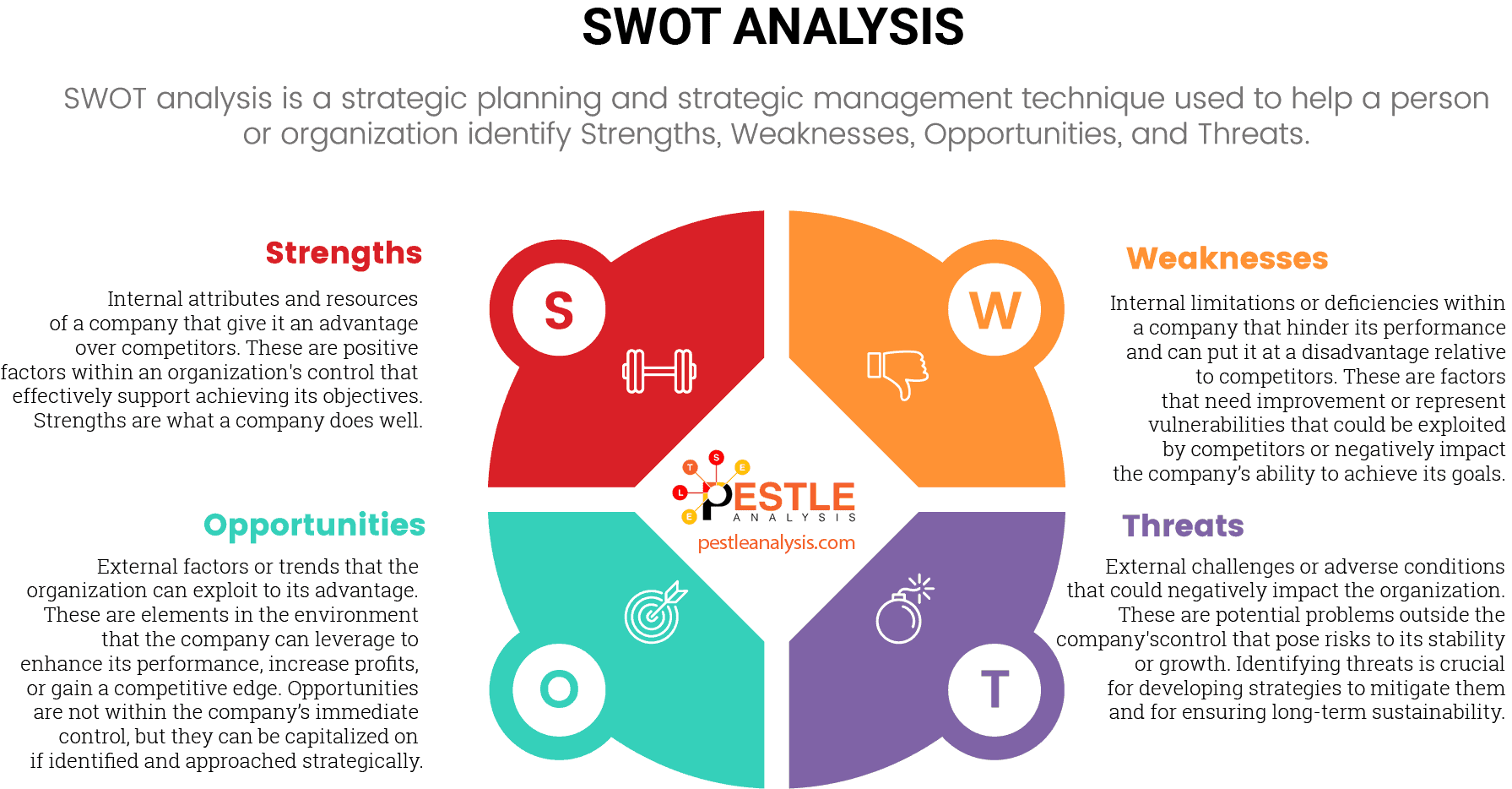
Having examined the four parts of a SWOT analysis, let's now look at the purpose of conducting a SWOT analysis in general.
Both individuals and businesses must possess the ability to self-analyze. Self-awareness is crucial for making well-informed decisions. For businesses, this involves understanding their strengths and weaknesses, which is essential for strategic decision-making.
For example, a clothing brand deciding to enter the cosmetic industry without self-analysis could make poor business decisions. However, if the brand knows it lacks resources for diversification, it can avoid potential failure. Businesses achieve self-awareness through the SWOT Matrix, identifying the company's strengths, weaknesses, opportunities, and threats.
SWOT analysis aids in decision-making processes, planning, and strategy development. It helps businesses identify growth opportunities and potential threats. By planning based on SWOT findings, businesses can mitigate risks and make informed decisions.
Integrating SWOT analysis provides a comprehensive view of internal and external factors affecting operations. It helps businesses retain strengths, address weaknesses, seize opportunities, and manage threats. Continuous evaluation of market trends, customer feedback, and performance through KPIs and regular SWOT analysis is essential for businesses to adapt and succeed in changing environments.
The Four Parts of a SWOT Analysis need Constant Updating
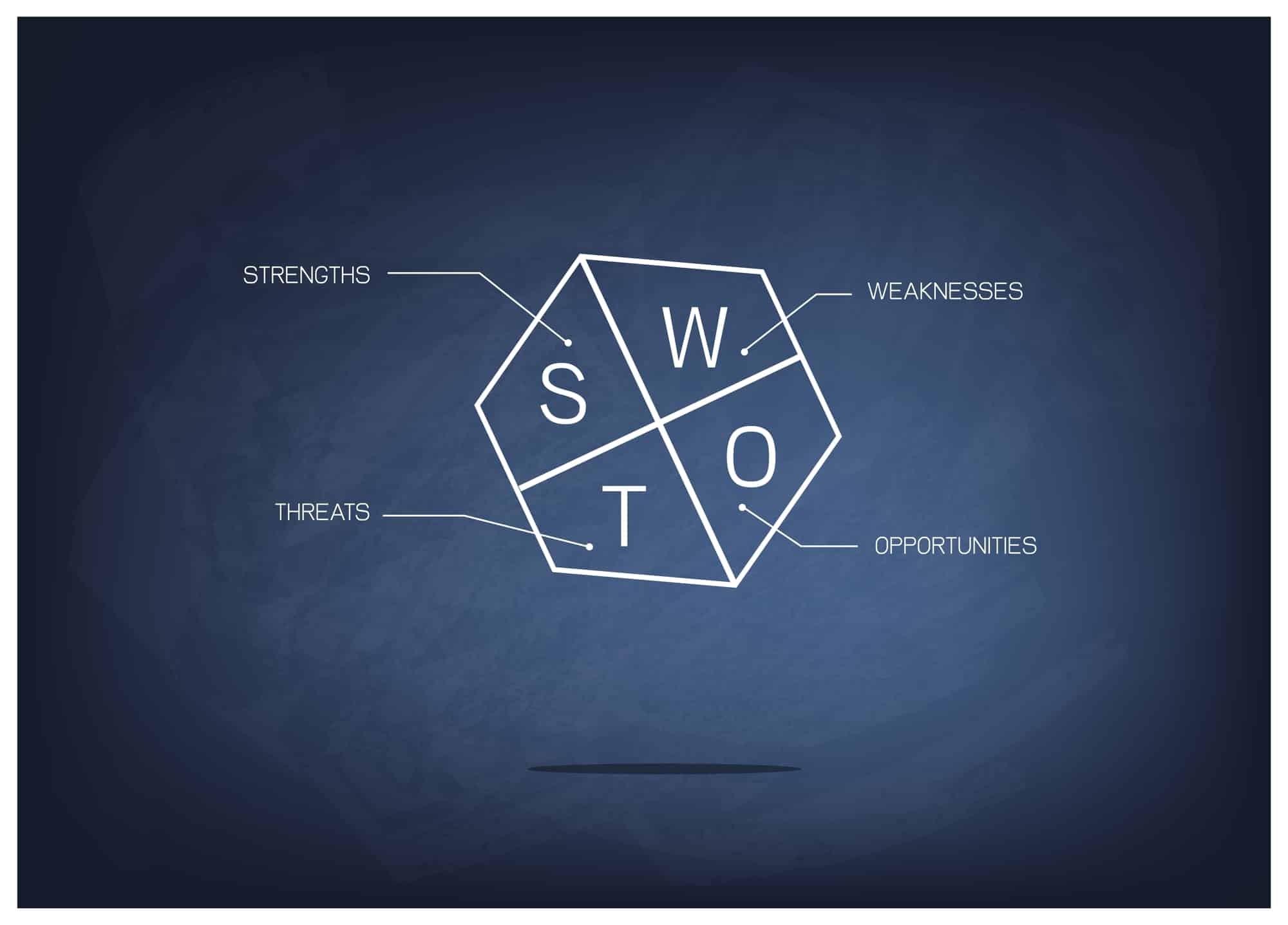
Just as a backyard fort needs regular maintenance to remain sturdy, businesses must continuously update their SWOT analysis to stay competitive and resilient. Regularly updating the four parts of a SWOT analysis—strengths, weaknesses, opportunities, and threats—is crucial for several reasons.
Adapting to Internal Changes
Businesses are dynamic entities with evolving strengths and weaknesses.
New technologies, shifts in management, changes in workforce skills, and financial fluctuations can all impact a company’s internal landscape. Regularly revisiting and updating the strengths and weaknesses sections of a SWOT analysis ensures that a small business remains aware of its current capabilities and limitations.
This awareness allows for timely strategic adjustments and resource allocations to leverage new strengths and address emerging weaknesses.
Responding to External Environment
The external business environment is in constant flux, influenced by market trends, economic shifts, technological advancements, and competitive actions.
Opportunities and threats identified in a previous SWOT analysis may no longer be relevant, while new ones may have emerged. By keeping the opportunities and threats sections of a SWOT analysis current, businesses can proactively respond to changes, seize new opportunities, and mitigate emerging threats.
This responsiveness is key to maintaining a competitive edge and ensuring long-term viability.
Enhancing Strategic Planning
An updated SWOT analysis provides a reliable foundation for strategic planning.
It offers a realistic view of where the business stands and what it faces, enabling more effective decision-making and strategic initiatives. Regular updates ensure that the business strategy aligns with the current internal and external environment, increasing the likelihood of success in achieving organizational goals.
Improving Risk Management
Businesses face numerous risks that can jeopardize their success.
Regularly updating the threats section of a SWOT analysis allows businesses to anticipate potential risks and develop strategies to counteract them. This proactive approach to risk management helps in minimizing the impact of adverse events and ensures the business is prepared for unforeseen challenges.
Facilitating Continuous Improvement
SWOT analysis is not a one-time exercise but an ongoing process of self-evaluation and improvement.
By consistently updating all four parts of the SWOT analysis, businesses can foster a culture of continuous improvement. This approach encourages regular assessment of performance, identification of improvement areas, and adaptation to new circumstances, ultimately leading to sustained growth and success.
In conclusion, the importance of keeping the four parts of any SWOT analysis updated cannot be overstated. Regular updates ensure that a business remains aware of its internal strengths and weaknesses, responsive to external opportunities and threats, and capable of making informed, strategic decisions. This ongoing process is essential for adapting to changes, managing risks, and achieving long-term success in a constantly evolving business environment.
That’s why we keep our SWOT analyses updated on PESTLEanalysis.com, ensuring that we remain transparent and prepared for any challenges or opportunities that come our way.








